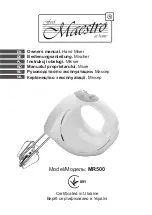
17
Owner’s Manual
Owner’
s Manual
Whatever your selection, you can also use the control
room outputs for other applications. Its sound quality is
just as impeccable as the main outputs. It can be used
as additional main mix output, which may sound silly
since there are already three, but this one has its own
level control. However, should you do something like
this, be sure that you do not engage a solo switch, as
that will interrupt your source selection.
35. Solo Mode (AFL/PFL)
Engaging a channel’s solo [24] switch will cause
this dramatic turn of events: Any existing source
matrix selections will be replaced by the solo signal,
appearing in the control room, headphones, and meter.
The audible solo levels are then controlled by the
control room / submix [34] fader. The solo levels
appearing on the right meter display are not controlled
by anything — you wouldn’t want that. You want to see
the actual channel level on the meter display regardless
of how loud you’re listening.
With this solo mode switch in the up position, you're
in AFL mode, meaning After-Fader-Listen. You'll hear
the output of the soloed channel and it will follow the
gain, EQ, fader and pan settings. It's similar to muting
all the other channels, but without the hassle. Use AFL
mode during mixdown.
With the solo mode switch in the down position,
you're in PFL mode, meaning Pre-Fader-Listen
(post EQ). This is required for the level setting
procedure, and is handy for quick spot-checks of
channels, especially ones that have their faders
turned down.
In either mode, solo will not be affected by a
channel's mute/alt [25] switch position.
36. Rude Solo Light
This flashing Light Emitting Diode serves two
purposes — to remind you that at least one channel
is in solo, and to let you know that you’re mixing on
a 1402VLZ4. No other company is so concerned about
your level of solo awareness. If you work on a mixer
that has a solo function with no indicator lights, and
you happen to forget you’re in solo, you can easily be
tricked into thinking that something is wrong with your
mixer. Hence the rude solo light. It’s especially handy
at about 3 a.m. when no sound is coming out of your
monitors but your multitrack is playing back like mad.
37. Assign To Main Mix
Let’s say you’re doing a live show. Intermission is
nearing and you’ll want to play a soothing CD for the
crowd to prevent them from eating the furniture.
Then you think, “But I have the CD player plugged into
the tape inputs, and that never gets to the main outs!”
Oh, but it does. Simply engage this switch and your
control room source selection, after going through
the control room / submix [34] fader, will feed into
the main mix, just as if it were another stereo channel.
Another handy use for this switch is to enable the
alt 3-4 mix to become a submix of the main mix, using
the control room/submix fader as its level control.
Side effects: (1) Engaging this switch will also feed
any soloed channels into the main mix, which may be
the last thing you want. (2) If you have main mix as
your control room source selection and then engage
assign to main mix, the main mix lines to the control
room will be interrupted to prevent feedback. Then
again, why would anyone want to assign the main mix
to the main mix?
38. Meters – Many Displays In One!
The 1402VLZ4’s peak metering system is made up
of two columns of twelve LEDs. Deceptively simple,
considering the multitude of signals that can be
monitored by it.
If nothing is selected in the source matrix and
no channels are in solo, the meters will just sit there
and do nothing. To put them to work, you must make a
selection in the source matrix (or engage a solo switch).
Why? You want the meter display to reflect what the
engineer is listening to, and as we’ve covered, the
engineer is listening either to the control room outputs
or the phones outputs. The only difference is that while
the listening levels are controlled by the control room
/ submix [34] knob, the meters read the source mix
before that control, giving you the real facts at all times,
even if you’re not listening at all.
Thanks to the 1402VLZ4’s wide dynamic range,
you can get a good mix with peaks flashing anywhere
between –20 and +10 dB on the meters. Most
amplifiers clip at about +10 dB, and some recorders
aren’t so forgiving either. For best real-world results,
try to keep your peaks between “0” and “+7”.
You may already be an expert at the world of “+4” (+4
dBu=1.23 V) and “–10” (–10 dBV=0.32 V) operating
levels. Basically, what makes a mixer one or the other
is the relative 0 dB VU (or 0 VU) chosen for the meters.
A “+4” mixer, with a +4 dBu signal pouring out the back
will actually read 0 VU on its meters. A “–10” mixer,
with a –10 dBV signal trickling out, will read 0VU on its
meters. So when is 0 VU actually 0 dBu? Right now!












































